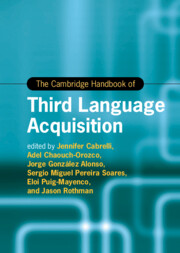Book contents
- The Cambridge Handbook of Third Language Acquisition
- Cambridge Handbooks in Language and Linguistics
- The Cambridge Handbook of Third Language Acquisition
- Copyright page
- Contents
- Figures
- Tables
- Contributors
- Introduction Multilingualism
- Part I Theoretical Approaches to L3/Ln
- Part II L3/Ln across Linguistic Domains
- 5 Exploring the Acquisition of L3 Phonology
- 6 Characteristics of the L3 Lexicon
- 7 Processing Words in a Multilingual Lexicon
- 8 Full Transfer in L3/Ln Acquisition
- 9 Full Transfer Potential in L3/Ln Acquisition
- 10 The Acquisition and Processing of Pragmatics in Multilinguals and Third Language Learners
- Part III Becoming and Staying Multilingual at Different Ages
- Part IV L3/Ln in Action
- Part V L3/Ln and Cognition
- Part VI Research Methods in L3/Ln
- Index
- References
8 - Full Transfer in L3/Ln Acquisition
Evidence from Two Clusters of Studies
from Part II - L3/Ln across Linguistic Domains
Published online by Cambridge University Press: 13 July 2023
- The Cambridge Handbook of Third Language Acquisition
- Cambridge Handbooks in Language and Linguistics
- The Cambridge Handbook of Third Language Acquisition
- Copyright page
- Contents
- Figures
- Tables
- Contributors
- Introduction Multilingualism
- Part I Theoretical Approaches to L3/Ln
- Part II L3/Ln across Linguistic Domains
- 5 Exploring the Acquisition of L3 Phonology
- 6 Characteristics of the L3 Lexicon
- 7 Processing Words in a Multilingual Lexicon
- 8 Full Transfer in L3/Ln Acquisition
- 9 Full Transfer Potential in L3/Ln Acquisition
- 10 The Acquisition and Processing of Pragmatics in Multilinguals and Third Language Learners
- Part III Becoming and Staying Multilingual at Different Ages
- Part IV L3/Ln in Action
- Part V L3/Ln and Cognition
- Part VI Research Methods in L3/Ln
- Index
- References
Summary
The aim of the chapter is to first discuss the theoretical motivations for Full Transfer as well as some methodological considerations one needs to adopt when testing whether there is Full or property-by-property transfer in L3/Ln acquisition. The chapter then provides an overview of two clusters of studies providing some empirical evidence towards Full Transfer at the initial stages of L3/Ln acquisition. The first cluster of studies examined is that of the acquisition of Brazilian Portuguese by bilingual English–Spanish speakers, illustrating how bringing together these 16 studies can be helpful when evaluating the tenets of the theoretical proposals that predict Full Transfer. The second is that of Catalan–Spanish bilinguals acquiring L3 English. By reviewing these seven different studies, it is shown how Full Transfer applies in cases where structural similarity between the Lx/Ly and L3 is not straightforward. The chapter ends by suggesting some directions for future research.
- Type
- Chapter
- Information
- The Cambridge Handbook of Third Language Acquisition , pp. 195 - 218Publisher: Cambridge University PressPrint publication year: 2023



